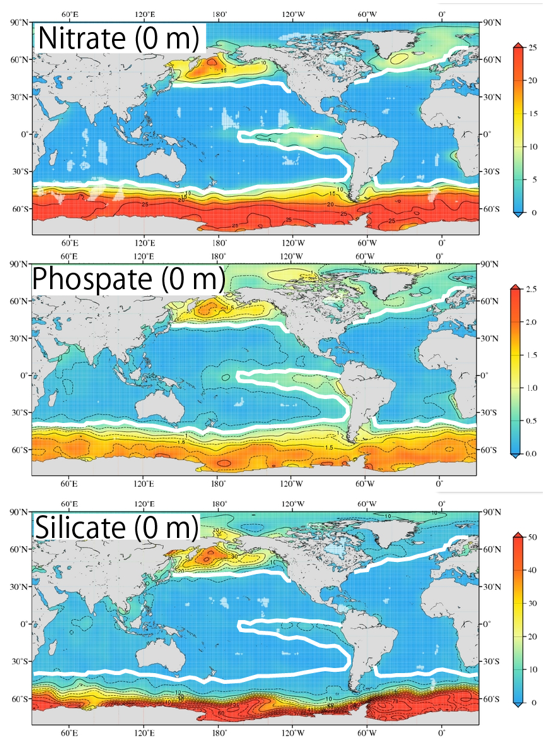Which nutrient, silicate, nitrate or phosphate, is the limiting factor for base production? It is one of the most important topics in ocean chemistry. Now let's compare the nutrient distribution on the ocean surface.

Bold white line: Boundry of phosphate concentration=0.5μmol/L
The bold white line is the boundary that phosphate concentration is 0.5 µmol/L. The redder range than the bold white line is where 0.5 µmol/L phosphate is present. If there is an annual average of 0.5 µmol/L phosphate on the ocean surface, the ocean is rich in phosphate. Based on this, the biological production and nutrient balance of the ocean will be explained.
Nutrient-rich Productive Ocean
If All of PO43-, NO3-, and Si(OH)4 are in good balance, the ocean is called nutrient-rich, ideal for diatom growth. The most productive areas for diatom proliferation are (1) the Southern Ocean south of 60°S and (2) the North Pacific subarctic zone (north of 35°N). The below two areas are with low Si(OH)4 but good nutrient balance; (3) the high-latitude North Atlantic and (4) the eastern equatorial Pacific. When Si(OH)4 is in short supply, coccolithophore and other algae that form calcium carbonate shells, rather than silica shells, proliferate. In any case, these waters have been found to have high concentrations of chlorophyll.
Silicate depleted Ocean
On the other hand, although PO
43- and NO
3- are abundant, Si(OH)
4 is significantly deficient in (5) the Southern Ocean at 40-50°S latitude. Diatom growth is limited in this region.
Nitrate depleted Ocean
In addition, although PO43- and Si(OH)4 are abundant, NO3- is significantly deficient in the Arctic Ocean on the Pacific side (6) (north of the Bering Strait). In this region, diatom blooms occur during the melting of sea ice (early summer) and nutrients are rapidly consumed. In summer, the near-surface area of the Arctic Ocean is covered by low-salinity, high-temperature (plus a few degrees Celsius) sea ice meltwater. The surface layer becomes significantly stratified, so nutrient-rich sub-surface water is no longer brought to the surface. As a result, a NO3- deficient situation is likely to occur. (Loss of nutrient nitrogen due to nitrate reduction in shelf sediments may also be a cause.)
Oligotrophic Ocean
All nutrients are depleted in the subtropical ocean. Subtropical waters, which account for a large proportion of the total oceanic area, are considered to have low biological production, as they are called "deserts of the sea". However, it is thought that the amount of "regenerative production" is large because organic matter produced in the surface layer remineralized in the surface layer. It will be interesting to see how efficiently a few nutrients are utilized in the subtropical ocean.
Name seven areas of the ocean that would be interesting in discussing nutrient distribution and biological productivity.
① South of 60°S in the Southern Ocean → All major nutrients are abundant
②North Pacific subarctic (north of 35°N) → All major nutrients are abundant
③High Latitude North Atlantic → Rich in phosphate and nitrate Slightly poor in silicic acid
④ Eastern Equatorial Pacific → Rich in phosphate and nitrate Slightly poor in silicic acid
⑤40-50°S in the Southern Ocean → Rich in phosphate and nitrate Slightly poor in silicic acid
⑥the Arctic Ocean → Poor in nitrate
⑦ Subtropical Ocean → Poor in each nutrient
I will present a case study of Si uptake by phytoplankton and then NO3- deplete in the Arctic Ocean. Then, in the next chapter, I will explain the limitation of primary production by micronutrient Fe.
Si uptake by phytoplankton
To discuss nutrient uptake by phytoplankton and nutrient depletion in seawater, the Redfield ratio (C:N:P = 106:16:1) is the usual method. However, the Si ratio is not added to the Redfield ratio because the organisms that require Si are limited to diatoms and radiolarians, and the thickness of the silicate shell varies depending on the trophic state, so the constant Si ratio cannot be given. Nevertheless, it is still important to consider silicate uptake, so the Si uptake ratios of certain diatom species and under certain trophic conditions have been investigated. Here are some examples of studies on Si uptake by marine phytoplankton.